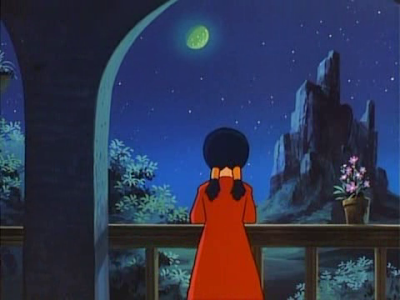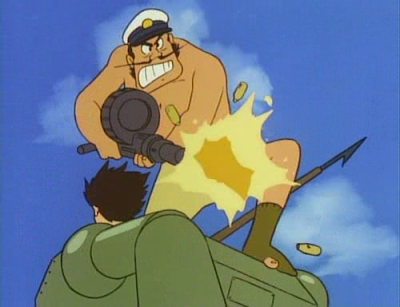
So, I just finished watching Hayao Miyazaki's 1978 TV series The Future Boy Conan and I'm absolutely stunned by the quality exhibited in this show both in its narrative qualities and in the background artwork and animation.
The story starts after world war III devastates the planet, sinking the continents and killing billions of people "in an instant", as the opening describes.

A boy named Conan grows up on an island with his grandfather 20 years after the war. For him life was peaceful but his grandfather worries that they may be the last humans left on Earth...
...until a young girl named Lana washes up on the beach.
And then adventure ensues.
I won't get into plot specifics, but I'll post pictures from the series that exemplify what is so great about it.
Backgrounds:

My god, how great are these backgrounds?
I'm a sucker for jungle scenes and there are plenty of them throughout the show.


High Harbor, the island paradise where everyone works for each other. It's basically communism, but it works in this small community.



The graves of millions.
 | |
| This is civilization circa 2008 before it all exploded. |
Back to High Harbor:

Animation:
You need to see this crawl. Click on the image to view the GIF.




I think one has to put this into the context of the time. When I think of the late-seventies in terms of TV animation, it was pretty dismal. The U.S. had, what, Jabberjaw?



And while all this silliness is going on there are beautiful backgrounds.

 |
| Conan has a tough emotional moment here. |
 |
| Captain Dyce, who had some of the better facial expressions throughout the show. |
Narrative and Thematic Elements:
One of the first things I noticed was the swearing throughout the show. Had it been released as a movie today, the pervasive language could have possibly garnered it a PG-13 rating. And while it was strange at first to see it in what I had assumed was a raucous boy's adventure series, it gave the world Conan inhabited an extra degree of reality and truthfulness. As with most great animation, this wasn't just aimed at the kids.


Obviously, the next aspect that struck me was the abundance of threatening the main child characters with serious physical harm. In a sense it harkens back to Jonny Quest, except Conan never shoots back, opting to instead use his immense strength and agility to get out of situations.

 |
| Jimsy, drunk. |
And then, of course, there is the brutal beating scene on the boat Conan and his friend Jimsy stow away on:
 |
| Brutal! |
 | |||
| Another beating for a different incident |

That is, until the Industrians come looking for her.
The look on his face at the end was always on my mind whenever harm came to the children from the adults later in the show.
 |
| Lepka: Asshole |
 |
| They're watching you. |
There's a real sense of the realities of death and a serious consideration of the consequences.
 | |
| Of course, this is a joke. |
 |
| Lana freaks out in the "virtual park" built in Industria to simulate a normal world. |
 Conclusion:
Conclusion:The Future Boy Conan has a timeless quality to it. The struggle to live in peace, to live harmoniously with the Earth, and to learn from the mistakes of our past are all essential values, and Conan presents them in a way that isn't preachy or overly sentimental. It makes them seem as if we couldn't live any other way, literally.
Compared to the time it was made, Conan is truly ambitious. Through today's eyes, the closest recent comparison would be to Avatar: The Last Airbender, which I also love. But Conan is more raw, uncensored, and frank in its portrayal of character, violence, and suffering. But it's also sweet, innocent, and honest. It's funny, exciting, beautiful, and a bunch of other adjectives. The Future Boy Conan should rank as one of the best examples of what a long-form animated story can give. And for this wonderful experience I thank you, Miyazaki.








































No comments:
Post a Comment